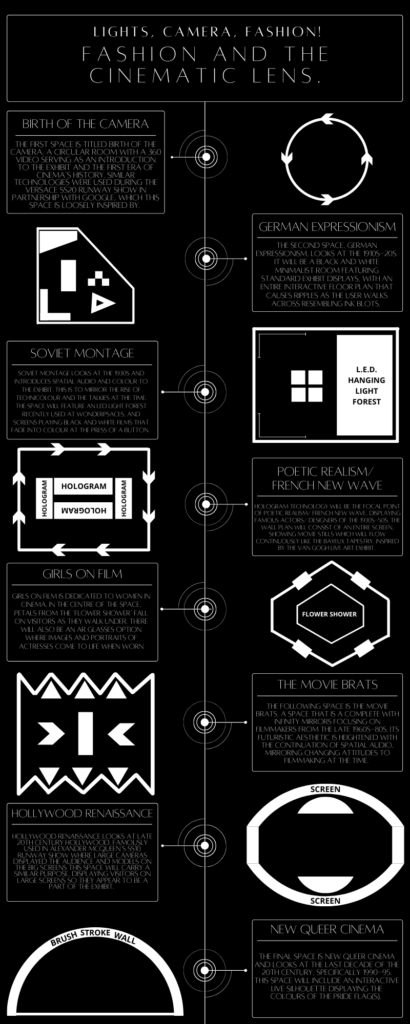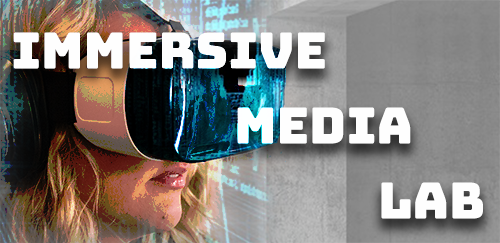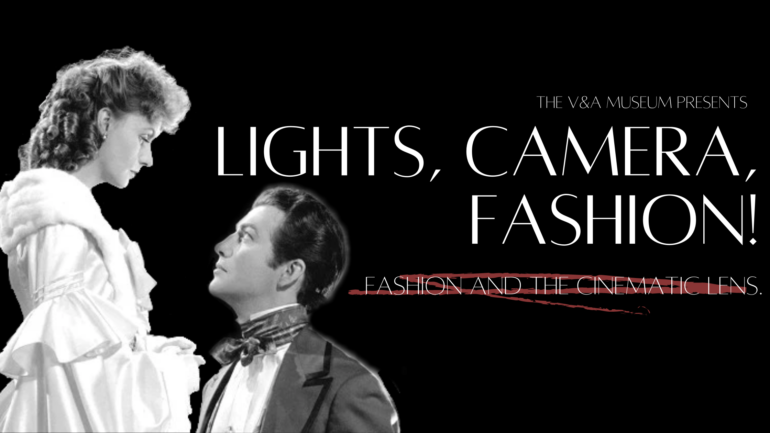I believe it is appropriate to say that the fashion and film industries have impacted us individually one way or another. In fact, the global fashion market is valued at $300 billion as of 2020 (Deslandes, 2020), with the global box office rates reaching a combined total of $42.2 billion in 2019 (Theme Report, 2020). However, the question regarding whether fashion and costume should be recognised as a legitimate art form still circulates cultural debate. In a historical sense fashion has scarcely been categorised on the same stature of value as painting, sculpture, and architecture (Berges, 2017), and was even seen as ‘unworthy’ of being a part of museum exhibits (Steele, 2008, p.9). As a response to this I have thus proposed an immersive museum exhibit that showcases fashion in relation to the film industry titled; ‘Lights, Camera, Fashion!’: Fashion and the Cinematic Lens.
Divided into eight unique environments the exhibit aims to present fashion in a manner that retells the history and development of popular cinema, combining both entertainment and educational characteristics. Each space introduces unique immersive technologies and realities that complement the themes of the individual environments as the user embarks through the experience. In order to have a mass audience appeal the exhibit is designed with diverse purpose and thematic emphases on both layout and interactive technologies that will appear as a mature experience for adults however maintaining an appropriate aesthetic for younger audiences.

In order to appeal to a wide audience range the exhibit is designed as a one level floor plan divided into eight different environments. Therefore, the exhibit is easily accessible to those who are restricted to a wheelchair and to families who may have young children in pushchairs. In terms of aestheticization and exhibit interior the experience features a range of both visual and audio technologies which are evenly distributed across the exhibition, thus still providing an element of enjoyment for those who may have a visual or hearing sensory deficit.
As aforementioned the exhibit is divided into eight separate environments, with fashion and immersive technology coming together to narrate the evolution of cinema. Though the experience structure conforms to a standard linear narrative the user will be able to fluctuate back and forth between the spaces non-chronologically, thus allowing the individual to have a little more freedom with the exhibit.
The first space is titled ‘Birth of the Camera’, a circular room with a 360 video wall serving as an introduction to the exhibit and the first steppingstone of cinema’s evolution. Similar technologies were used at the Versace SS20 runway show in Milan. The second space, ‘German Expressionism’, is a black and white minimalist room with standard exhibit displays, however the floor plan will be entirely interactive, leaving ink blots as the user walks across. This technology has been recently used in the Las Arenas shopping centre in Barcelona to create a memorable consumer experience (Haynes, 2018).
For the following space, ‘Soviet Montage’ introduces spatial audio and colour to the exhibit. The space will feature an LED hanging light forest recently used at Wonderspaces, providing an element of touch and ample photoshoot opportunity for photoshoots (Schweiker, 2020). To display cinema’s transition into technicolour, the space will feature screens playing black and white films that fade into colour when the user presses a button.
Hologram technology will be the focal point of the next space, ‘Poetic Realism/ French New Wave’, displaying actors and designers of the movement. This form of immersive media is re-emerging and seeing a ‘renaissance’ in technology culture (Young, 2020). The wall plan will consist of an entire screen showing movie stills which will flow continuously like the Bayeux Tapestry, inspired by the Van Gogh live art exhibit. ‘Girls on Film’ follows and is dedicated to women in cinema. In the centre of the space, petals from the ‘flower shower’ fall on visitors as they walk under. There will also be an AR glasses option where images and portraits of actresses come to life when worn, however I am debating whether to include this due to its technological sparseness.
Infinity mirrors will make up the complete ‘The Movie Brats’ sector of the exhibit, with the continuation of spatial audio to maintain a futuristic aesthetic. Famously used in Alexander McQueen’s SS10 runway show, the seventh space ‘Hollywood Renaissance’ includes large cameras displaying visitors on large wall screens, so they appear to be a part of the exhibit as they make their way through to the final space, ‘New Queer Cinema’. Re-introducing a passive interactive element to conclude the exhibit, the interior of the final space is centered around either an interactive brush stroke wall or a live silhouette display of the visitors’ movements, both in the colours of the pride flag(s).

